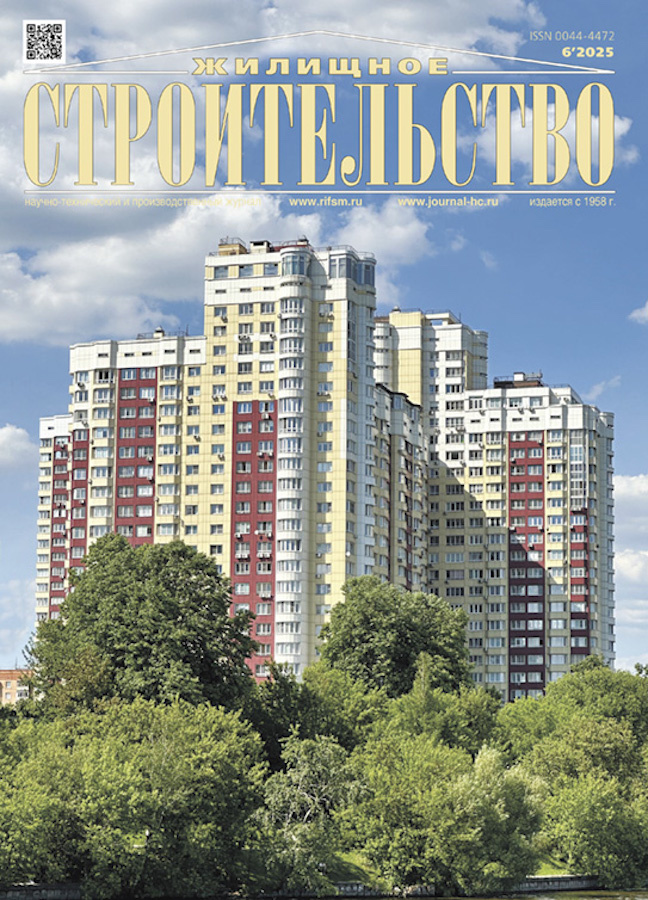Laboratory Studies of Ultra-High Sound Insulation of Enclosures
- 作者: Grebnev P.A.1, Monich D.V.1
-
隶属关系:
- Nizhny Novgorod State University of Architecture and Civil Engineering
- 期: 编号 6 (2025)
- 页面: 17-24
- 栏目: Articles
- URL: https://archivog.com/0044-4472/article/view/688276
- DOI: https://doi.org/10.31659/0044-4472-2025-6-17-24
- ID: 688276
如何引用文章
详细
In modern construction practice, enclosing structures with high and ultra-high sound insulating characteristics have come to be actively used. Such structures have rational design solutions according to the sound insulation criterion and are capable of providing the required noise protection of the existing interior spaces. These structures are classified into classes according to sound insulation criteria “A”, “A+”, “A++”. Evaluation of the proper sound insulation of such enclosures in reverberation chambers is complicated by the approach of the sound insulation of such enclosures to the limit values for the test bench used. To improve the accuracy of such studies, it is proposed to use the intensity measurement method. The article presents the results of experimental studies of structures with ultra-high sound insulation in the complex “Large Acoustic Chambers of NNGASU” using the standard technique and the intensity measurement method. In the experiments, indirect sound transmission through the stand structures was simulated by creating artificial sound paths between the reverberation chambers and generating interference noise directly in the low-level chamber. The convergence of the results of determining sound insulation by the two methods under consideration in the absence of interference noise is presented. It is shown that the intensity method allows obtaining reliable results of measuring sound insulation in the presence of flanking noise in the low-level chamber. The flanking noise levels at which ultra-high sound insulation of class “A++” structures can be obtained experimentally using the method of intensimetrу have been determined.
全文:
作者简介
P. Grebnev
Nizhny Novgorod State University of Architecture and Civil Engineering
编辑信件的主要联系方式.
Email: p.grebnev@mail.ru
Candidate of Sciences (Engineering)
俄罗斯联邦, 65, Ilyinskaya St., Nizhny Novgorod, 603000D. Monich
Nizhny Novgorod State University of Architecture and Civil Engineering
Email: dmitriy.monich@mail.ru
Doctor of Sciences (Engineering)
俄罗斯联邦, 65, Ilyinskaya St., Nizhny Novgorod, 603000参考
- Grebnev P.A. Typology of modern sound insulating enclosing structures. Privolzhskij Nauchnyj Zhurnal. 2024. No. 3, pp. 25–39. (In Russian). EDN: CQYYXD
- Kochkin N.A., Ivanova A.V., Shubin I.L., Kochkin A.A. Study of factors influencing sound in-sulation existing fences with additional sound insulation at the site using layered vibration-damped elements. Stroitel’nye Materialy [Construction Materials]. 2024. No. 6, рр. 40–45. (In Russian). EDN: XFAHAO. https://doi.org/110.31659/0585-430X-2024-825-6-40-45
- Fahy F.J. Sound Intensity. New York: Elsevier Applied Science. 1989. 285 p.
- Bies D.A., Hansen C.H. Engineering Noise Control. New York: Spon Press. 2009. 747 p.
- Lai J. C. S., Qi Dan. Sound transmission loss measurements using the sound intensity technique. Part 1: The effects of reverberation time. Applied Acoustics. 1993. Vol. 40, рр. 311–324. https://doi.org/10.1016/0003-682X(93)90091-J
- Lai J. C. S., Burgess Application of the sound intensity technique to measurement of field sound transmission loss. Applied Acoustics. 1991. Vol. 34, рр. 77–87. https://doi.org/10.1016/0003-682X(91)90023-8
- Tsukernikov I.E., Nevenchannaya T.O., Tikhomirov L.A., Shchurova N.E. Measuring the sound insulation of building products using intensity measurements. Collection of Proceedings of the XXXIV session of the Russian Acoustical Society. Moscow. 2022, pp. 519–527. (In Russian). EDN: YXQPGL. https://doi.org/10.34756/GEOS.2021.17.38125
- Tsukernikov I.E., Nevenchannaya T.O., Shchurova N.E. Assessment of measurement conditions when determining the sound insulation of building products using the intensity method in laboratory conditions. Noise Theory and Practice. 2024. Vol. 10. No. 2 (37), pp. 7–16. (In Russian). EDN: GKSSRY
- Tsukernikov I.E., Shchurova N.E, Nevenchannaya T.O. Estimation of criteria of validity of acoustic conditions of measurements of sound insulation of building products by the method of intensimetry according to ISO 15186-2 in full-scale conditions. BST: Bjulleten’ Stroitel’noj Tehniki. 2024. No. 6, pp. 8–12. (In Russian). EDN: ONSUZV
补充文件












